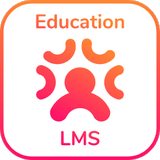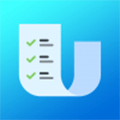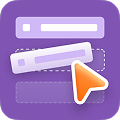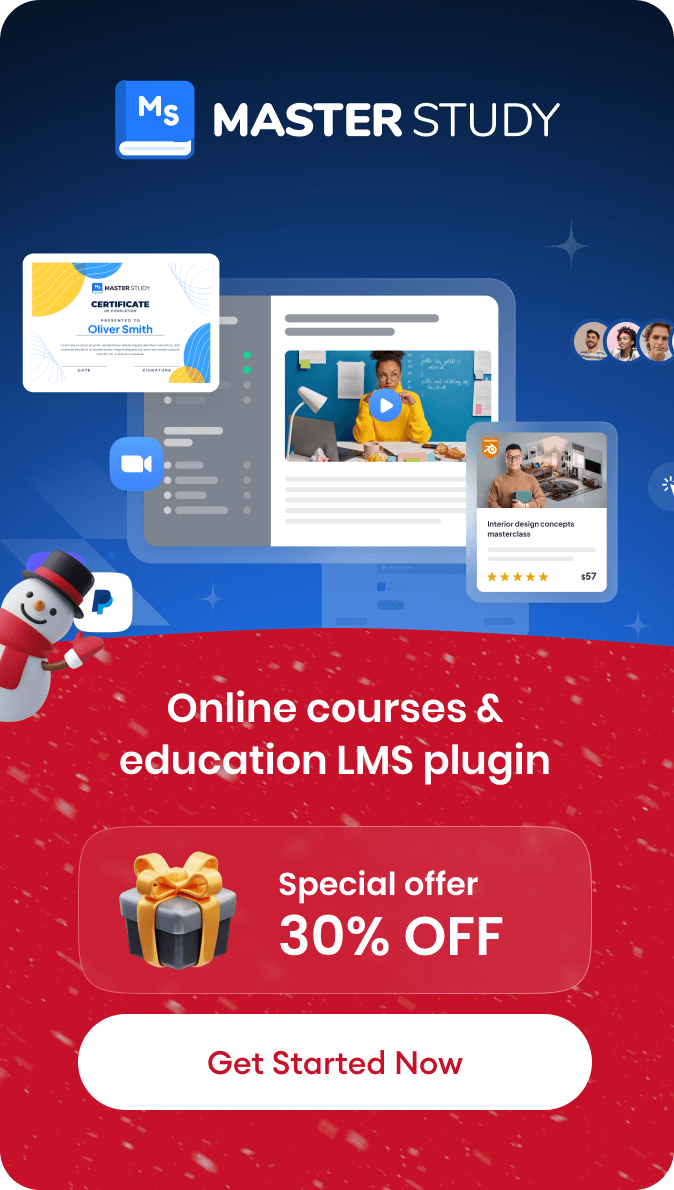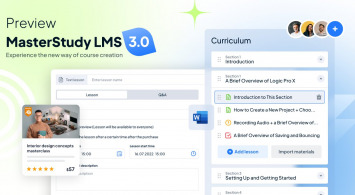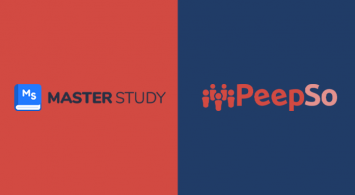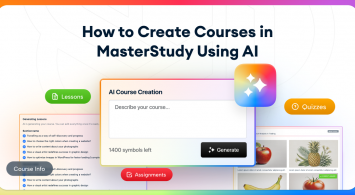Did you know that up to 85% of students never finish online courses?
That’s a big waste for entrepreneurs who spend thousands creating content, only to have learners sign up and never return. Engagement is more than just logging in. It’s sticking around, doing lessons, returning, and actually completing.
If your LMS platform is all about content delivery and not how learners experience it day after day, your conversions and revenue will suffer.
In this article, we’ll show five practical LMS features that improve engagement and completion with successful examples and numbers.
Why Low Engagement Destroys e‑Learning Businesses
Most LMS platforms are designed to deliver content. If you’re a course creator, coach, or e-learning business owner, you know that content alone doesn’t create results.
You may have high enrollments, but learners ghost your course after one or two lessons. It’s not because your content isn’t valuable. It’s because users aren’t activated. They’re not emotionally connected. They don’t feel progress.
Here’s the impact of low engagement:
- Low retention means fewer renewals
- Low completion means fewer success stories
- Low motivation means fewer referrals and lower ROI
Your course might be solid, but without engagement features, your learners stall. Modern learners want experience, interaction, and progress signals—not just video libraries.
You Can’t Fix Engagement Without the Right Features
Adding more lessons or longer videos won’t solve this. What learners need is guidance, motivation, and feedback. The right LMS features solve this problem.
They personalize learning, remove friction, and reinforce progress. Below are five features that consistently improve completion and satisfaction rates.
Build Personalized Learning Paths
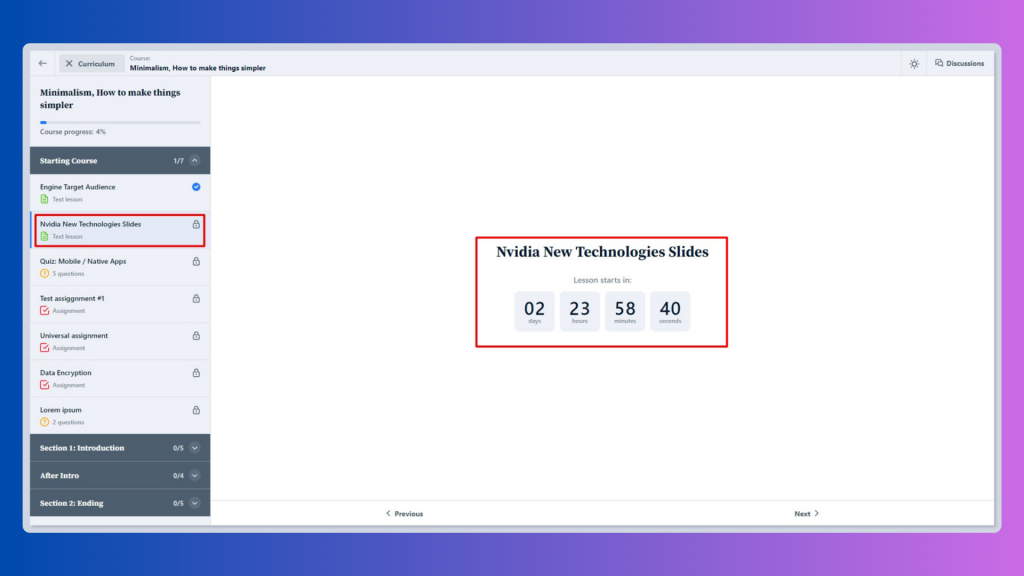
Everyone learns differently, at their own pace. Personalized learning paths help reduce overwhelm by giving learners a clear route to follow.
Instead of dumping everything into one long course, they unlock lessons only when learners complete earlier ones. This structure helps learners feel guided.
A common framework is sequenced tracks like Beginner → Intermediate → Advanced, or goal-based routes such as “Get Certified in 30 Days” or “Master Web Design in 5 Projects.”
LinkedIn Learning uses this model. Their platform offers curated learning paths like “Become a Project Manager” or “Learn Python from Scratch,” which combine multiple courses into a one linear journey.
According to their internal data, learners who follow guided paths are 2.1x more likely to complete a course compared to those browsing freely.
Let’s look at another case: A digital marketing academy split their course into three progressive tiers. Instead of letting users jump in anywhere, they locked modules until the previous ones were completed and added branching options for specialized topics.
The results:
- Course completion rate increased from 43% to 72%
- Time-on-page grew by 36%
- 6 out of 10 learners rated the structure as “the best part of the course”
Why does this work? It taps into the goal-gradient effect—the psychological principle that people work harder the closer they feel to a goal. When progress is visible and structured, motivation stays high.
How to implement it:
- Use lesson locking or module prerequisites
- Group lessons into milestone-based stages
- Offer optional branches based on learner needs
- Give learners visible progress tracking (e.g. 60% done)
Use Gamification Elements
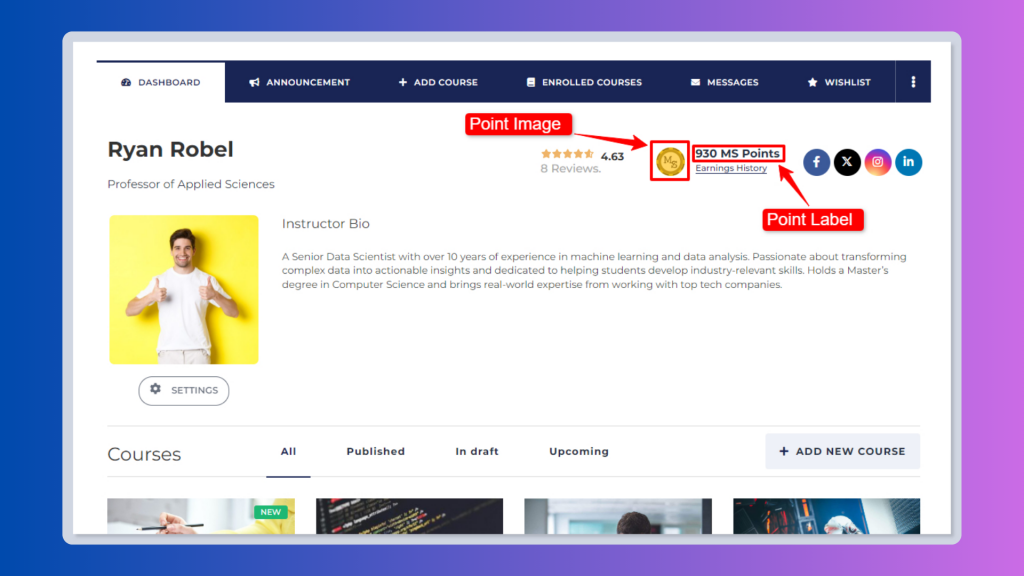
Gamification boosts course completion, motivation, and retention. Studies show gamified learning can increase retention rates by up to 90%, and boost learner engagement by over 60%, depending on design.
Features like points, badges, leaderboards, and weekly challenges are more than fun. They activate behavior. Research found that points significantly boosted emotional and participation engagement, while badges improved commitment (Source: SpringerOpen).
In a real-world example, a language school added weekly mini-challenges. Return visits increased by 30% in just 2 months.
A coaching course without any engagement features had a 12% quiz completion rate. After adding badges and weekly leaderboards, it jumped to 41%.
This is exactly why Duolingo’s streaks and XP points work so well—tiny rewards create real momentum.
Duolingo is a prime inspiration. It uses streaks, micro-rewards, and level-ups. These elements create tiny psychological rewards that keep learners coming back. Learners don’t get overwhelmed because they can complete their lessons in under 5 minutes and get points.
Their success shows that users become active when they have a sense of competition. Duolingo has a weekly leaderboard that encourages all learners to participate and get a chance to win.
Whether you’re a coach or course seller, you can add:
- Points for lessons completed
- Badges for milestones
- Leaderboards in live classes or groups
- Challenges every week or month
With such gamification elements, you will be able to design momentum.
Add Interactive Quizzes with Instant Feedback
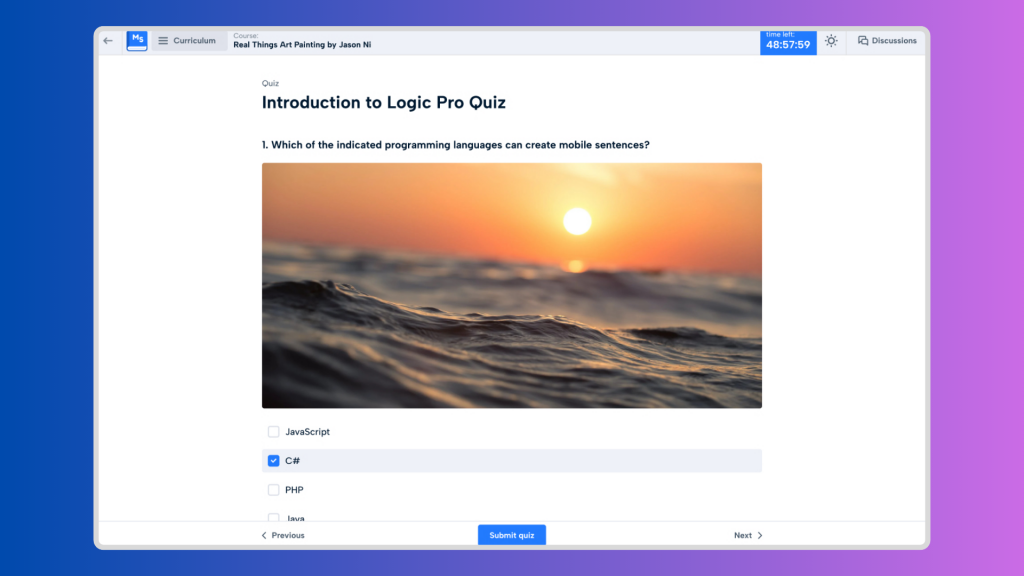
In an e-learning environment, quizzes aren’t simply tests. They’re actually effective learning tools when paired with instant feedback.
Students who receive instant feedback retain more information and stay active in the course longer. Instead of waiting until the end, short quizzes after every module help learners feel progress.
In one case, a finance course replaced PDFs with mini-quizzes between lessons. Dropout rates dropped by 25% in just three weeks. It wasn’t because the content changed, but because the quizzes kept learners moving.
Kahoot is a standout in this area. Originally built for classrooms, it now has over 9 million educators and companies actively using it worldwide.
Its success comes from real-time quizzes, playful design, and instant feedback. In a published study, students using Kahoot saw a 22% increase in test scores and reported higher motivation levels compared to traditional learning.
How to apply this to your LMS:
- Use low-stakes quizzes after each section
- Offer explanations with every right or wrong answer
- Let learners retry quizzes without penalty
- Keep quizzes short and varied (drag & drop, match, images)
Interactive quizzes shouldn’t feel hard. They just need to be engaging and frequent enough to guide the learner forward.
Create an Active Learning Community Inside Your LMS
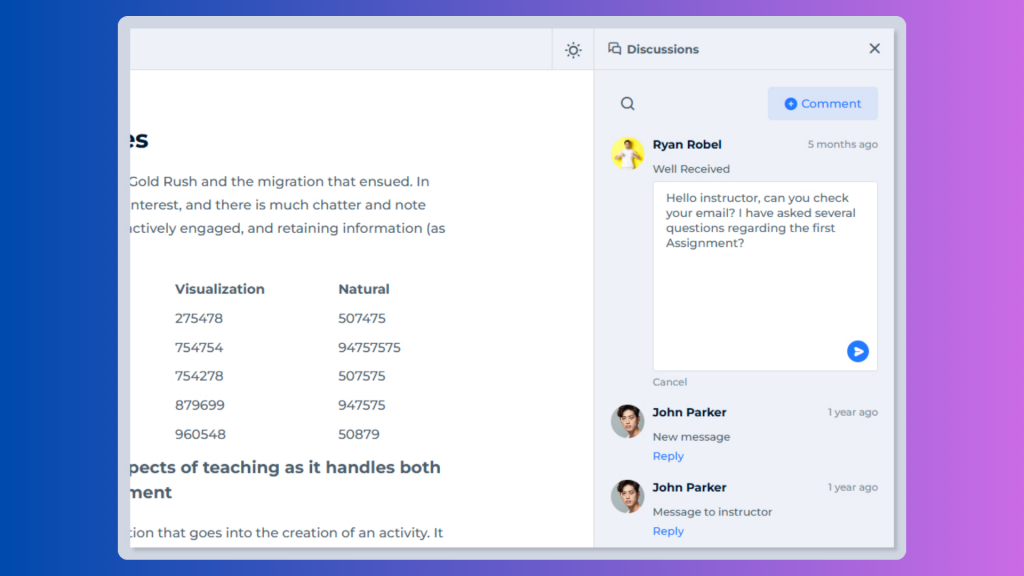
Students stay longer when they’re not learning alone. Community elements like group chat, discussion forums, lesson comments, and student profiles create a sense of belonging.
According to Harvard’s Teaching and Learning Lab, social learning environments promote deeper cognitive engagement and long-term retention.
Platforms like Teachable and Thinkific take advantage of community features.
Thinkific allows creators to build spaces within courses where learners can post, comment, and interact. Analytics show courses with active community features see up to 50% higher engagement among long-form program participants.
Teachable enables lesson comments and group engagement (sometimes via Circle integration). Their reports prove that creators using community tools have seen up to 3x increases in student engagement and repeat enrollment.
One financial learning course replaced static PDFs with interactive quizzes and saw dropout rates drop by 25%.
What you can do right now:
- Add comment threads or forums to lessons
- Encourage peer replies and reciprocal feedback
- Host live discussions or member events
Optimize for Mobile Learning with Push Notifications
Mobile experience in e-learning matters more than ever. In 2025, nearly 60% of learners consume online courses exclusively via their phones. A prep school doubled active user sessions by optimizing for mobile-first UX.
Seamless access from phones and tablets is essential. Push notifications like “you’re 75% done” can improve return rates by up to 40%.
Each part of your LMS platform, including interface, media playback, and quizzes, needs parity across devices. And if progress syncs across desktop and mobile, learners can continue where they left off with ease.
Coursera is a prime example of a mobile-first strategy done right. After launching its mobile app in 2014, it saw over 1 million installs in one year. But more importantly, mobile users started watching 30% of course content on phones and tablets.
What they achieved:
- Learners who used both desktop and mobile had 2.5x higher course completion rates compared to single-device users.
- Mobile users could download lessons, take adaptive quizzes, and receive personalized push reminders, which are all critical for ongoing motivation.
- In markets with limited desktop access, mobile drove significant learner growth and retention.
These results show that mobile optimization directly influences engagement and course completion.
Insights That Drive Smart Decisions
| Metric | Typical Benchmark | Influence |
|---|---|---|
| Course completion rate | 5–15% | Without engagement features, majority won’t finish |
| Mobile-first engagement | 2x higher | Learners interact twice as often on mobile |
| Gamification return visits | +35‑50% | Many studies support this range |
| Retention boost via gamification | up to 90% | Dramatic when design is intentional |
| Social learners’ completion chance | 16x more likely | Communities correlate to much higher finish rates |
Metrics like logins per week, forum activity, and quiz retries are more helpful to guide your strategy than just the number of enrollments. Pick 3 of them tied to your business goals and optimize.
What Works and What Doesn’t
Here’s a list of things that can contribute to low engagement in your course. What you should avoid doing with your LMS:
- Overloading dashboards. Too many features or lessons confuse learners; this can lead to decision paralysis.
- Delivering passive content. Students need interaction and check-ins, or they lose momentum.
- Ignoring mobile. If they can’t easily access courses on a phone, they won’t commit.
There are a few tips you can use to incorporate into your e-learning platform. What successful creators do:
- Start simple. Choose two features that feel right for your course and implement them. Test interactive quizzes or gamification elements before adding them.
- Use micro‑goals like badges and checklists to guide learners step by step. It improves their motivation.
- Keep feedback useful and human, not just numeric. This helps build their confidence.
- Adjust based on data and learner feedback. After adding one feature, check how much your engagement increased and students’ reaction, whether they like it or not.
- Small touches—a progress bar, quiz tip, welcome message—go a long way
Even low-tech courses benefit from thoughtful design. Community may begin slowly, but consistency turns it into a powerful retention engine.
Top LMS Features That Drive High Engagement and Boost Completion
There’s no need for an advanced tech stack to engage your students. You can add a few features that shape behavior smartly and involve your learners to make them come back.
That’s where MasterStudy LMS comes in. It lets you activate behavioral triggers in learning without overcomplicating the process. You’re not buying features, you’re designing an experience.
Here are the key features that actually help you do that. They are backed by research and used by platforms that know how to keep users hooked.
| Engagement Problem | Solution in MasterStudy | How It Helps |
|---|---|---|
| Learners skip ahead or lose focus | Lesson flow control | Guide progress with dependency, drip content, and lesson lock |
| Motivation drops mid-course | Points and badges | Reward course progress with visible achievements |
| Poor quiz engagement | Media-rich quizzes | Make quizzes fun and informative |
| Learners feel isolated | Discussions and community | Enable in-course questions and social interaction |
🔍 More on how these work in MasterStudy LMS:
- Lesson flow control: Use lesson dependency to prevent skipping. Combine with drip content to release lessons over time or in a set order. The lesson lock feature ensures learners must engage with video, audio, or documents before continuing.
- Points and badges: Award points automatically as users complete lessons or quizzes. Reward with badges when a course is finished great for recognition and motivation.
- Media-rich quizzes: Include different question types (dropdowns, multiple choice, image-based), add media, and provide answer explanations. This improves understanding and keeps learners thinking.
- Discussions and community: The built-in discussion panel lets learners ask teachers and peers questions inside lessons. Want full community features like groups and social feeds? PeepSo integration turns your LMS into a connected learning hub.
You can explore them on live demo.
Conclusion
An LMS doesn’t engage learners on its own. Your decisions do.
Begin with empathy: what would frustrate or motivate you as a learner? You won’t need every advanced feature. You need the right ones, executed thoughtfully.
Start with learning paths, gamification, interactive quizzes, or community spaces. Use them as building blocks. Design around clarity, motivation, and trust.
If you’re looking for a platform that supports these features without relying on extra plugins, MasterStudy LMS offers them all in one place. But whatever you decide to use, engagement is not tied to a feature. It’s the result of small, intentional choices made for your learners.
That’s where real learning transformation begins.
















